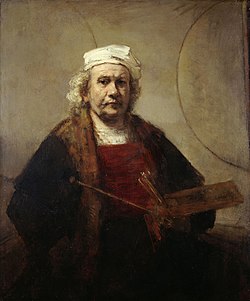
Back فنون جميلة Arabic Təsviri sənət Azerbaijani Изящно изкуство Bulgarian চারুকলা Bengali/Bangla Belles arts Catalan ھونەرە جوانەکان CKB Krásná umění Czech Skønne kunster Danish Καλές τέχνες Greek Belartoj Esperanto



In European academic traditions, fine art (or, fine arts) is made primarily for aesthetics or creative expression, distinguishing it from popular art, decorative art or applied art, which also has to serve some practical function, such as pottery or most metalwork. In the aesthetic theories developed in the Italian Renaissance, the highest art was that which allowed the full expression and display of the artist's imagination,[1] unrestricted by any of the practical considerations involved in, say, making and decorating a teapot. It was also considered important that making the artwork did not involve dividing the work between different individuals with specialized skills, as might be necessary with a piece of furniture, for example.[2] Even within the fine arts, there was a hierarchy of genres based on the amount of creative imagination required, with history painting placed higher than still life.
Historically, the five main fine arts were painting, sculpture, architecture, music, and poetry. Other "minor or subsidiary arts" were also included, especially performing arts such as theatre and dance, which were counted as "among the most ancient and universal."[3] In practice, outside education, the concept is typically only applied to the visual arts. The old master print and drawing were included as related forms to painting, just as prose forms of literature were to poetry. Today, the range of what would be considered fine arts (in so far as the term remains in use) is commonly includes additional modern forms, such as film, photography, and video production/editing, as well as traditional forms made in a fine art setting, such as studio pottery and studio glass, with equivalents in other materials.
One definition of fine art is "a visual art considered to have been created primarily for aesthetic and intellectual purposes and judged for its beauty and meaningfulness, specifically, painting, sculpture, drawing, watercolor, graphics, and architecture."[4] In that sense, there are conceptual differences between the fine arts and the decorative arts or applied arts (these two terms covering largely the same media). As far as the consumer of the art was concerned, the perception of aesthetic qualities required a refined judgment usually referred to as having good taste, which differentiated fine art from popular art and entertainment.[5]

The word "fine" does not so much denote the quality of the artwork in question, but the purity of the discipline according to traditional European canons.[7] Except in the case of architecture, where a practical utility was accepted, this definition originally excluded the "useful" applied or decorative arts, and the products of what were regarded as crafts. In contemporary practice, these distinctions and restrictions have become essentially meaningless, as the concept or intention of the artist is given primacy, regardless of the means through which it is expressed.[8]
The term is typically only used for Western art from the Renaissance onwards, although similar genre distinctions can apply to the art of other cultures, especially those of East Asia. The set of "fine arts" are sometimes also called the "major arts", with "minor arts" equating to the decorative arts. This would typically be for medieval and ancient art.
- ^ "Fine Art: Definition, Meaning, History". www.visual-arts-cork.com. Retrieved 8 June 2023.
- ^ Blunt, 48–55
- ^ Colvin, Sidney (1911). . In Chisholm, Hugh (ed.). Encyclopædia Britannica. Vol. 10 (11th ed.). Cambridge University Press. pp. 355–375.
- ^ "Fine art". Dictionary.reference.com. Retrieved 13 March 2014.
- ^ "Aesthetic Judgment". The Stanford Encyclopedia of Philosophy. 22 July 2010.
- ^ Drutt, Matthew; Malevich, Kazimir Severinovich; Gurianova, J. (2003). Malevich, Black Square, 1915, Guggenheim New York, exhibition, 2003-2004. Guggenheim Museum. ISBN 9780892072651. Retrieved 18 March 2014.
- ^ CLOWNEY, DAVID (2011). "Definitions of Art and Fine Art's Historical Origins". The Journal of Aesthetics and Art Criticism. 69 (3): 309–320. doi:10.1111/j.1540-6245.2011.01474.x. ISSN 0021-8529. JSTOR 23883666.
- ^ Maraffi, Topher. "Using New Media for Practice-based Fine Arts Research in the Classroom" (PDF). University of South Carolina Beaufort. Archived (PDF) from the original on 9 October 2022.
{{cite journal}}: Cite journal requires|journal=(help)